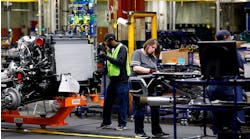On Target Defense contractor keeps customers in sights.
ByDavid DrickhamerAlenia Marconi Systems Operations Division Broad Oak, Portsmouth, EnglandAt a glanceWeb Exclusive Best Practices Alenia Marconi Systems, manufacturer of radar systems, missiles, defense equipment. By David Drickhamer Benchmarking Contact: Fred Attwood, Business Improvement Manager,
[email protected], +44 (0) 23 92 226533
Training The Broad Oak facility has been an accredited "Investor in People" since 1997. The formal standard provides a national framework in the UK for improving business performance and competitiveness by setting and communicating business objectives and developing people to meet those objectives. The goal is to match what people can do and are motivated to do with what the organization needs them to do. The Investors in People Standard is based on four key principles:
What our People can expect of Alenia Marconi Systems What Alenia Marconi Systems Expects of Our People
- Productivity, annual value-added per employee, up 34% over last five years.
- Rework down from 14% in 1996-97 to less than 1% today.
- Work-in-process inventory down 30% over the last four years.
- Commitment--Commitment to invest in people to achieve business goals.
- Planning--Planning how skills, individuals and teams are to be developed to achieve these goals.
- Action--Taking action to develop and use necessary skills in a well-defined and continuing program directly tied to business objectives.
- Evaluating--Evaluating outcomes of training and development for individuals' progress toward goals, the value achieved, and future needs.
- To be led and managed professionally and competently.
- To be treated equitably and with respect, courtesy, and consideration.
- To be provided with open channels of communication, listened to, and informed.
- To be motivated and challenged to contribute to the best of your individual capability.
- To be set stretching, yet achievable objectives and be regularly appraised of your performance.
- To be recognized and rewarded on the basis of your skill, performance, and contribution.
- To be given opportunities to develop to your full potential.
- To be provided with the tools and training to do your current job efficiently and effectively.
- To have a safe and pleasant working environment.
- To take personal responsibility for your work, performance, and career.
- To strive to continuously increase your level of performance.
- To be flexible and adaptable, understanding who your customers are and always being responsive to their needs.
- To be innovative, continuously seeking new and better ways of doing things.
- To seek and to grasp opportunities to achieve and develop.
- To work well with others, within and beyond your existing team.
- To take responsibility for continually learning and re-learning so that skills are up-to-date.
- To take pride in the company and be committed to its aims.
Sponsored Recommendations
Sponsored Recommendations
Voice your opinion!
Voice your opinion!
To join the conversation, and become an exclusive member of IndustryWeek, create an account today!
Members Only Content
Members Only Content
Members Only Content
Sponsored
Sponsored



